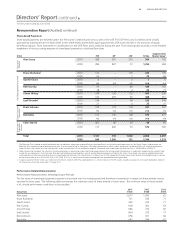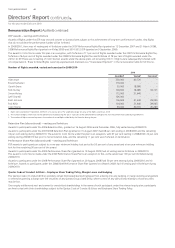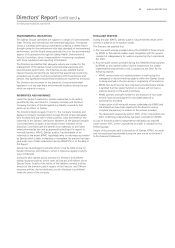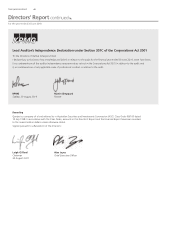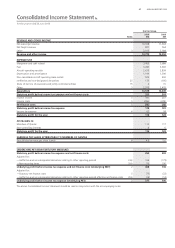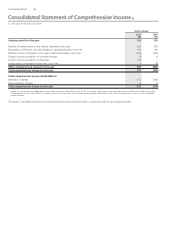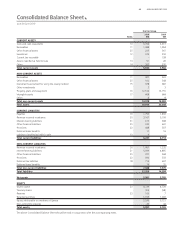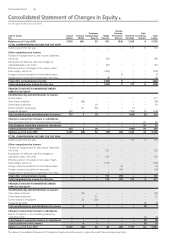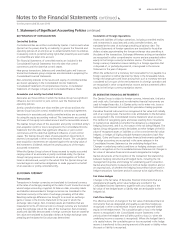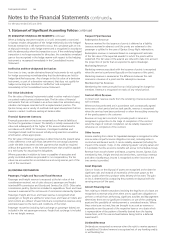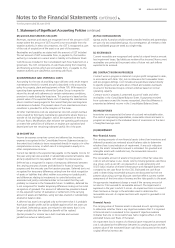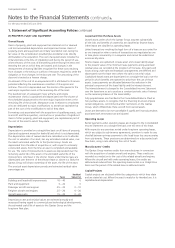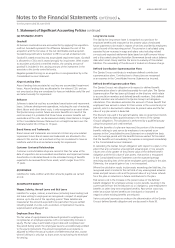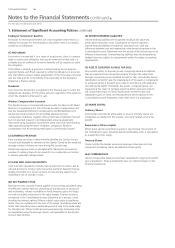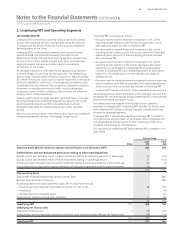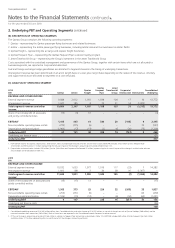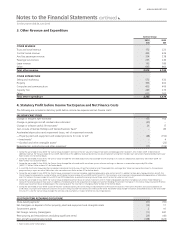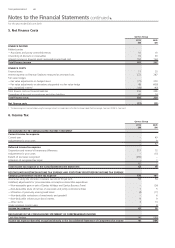Qantas 2010 Annual Report Download - page 54
Download and view the complete annual report
Please find page 54 of the 2010 Qantas annual report below. You can navigate through the pages in the report by either clicking on the pages listed below, or by using the keyword search tool below to find specific information within the annual report.
THE QANTAS GROUP 52
for the year ended 30 June 2010
Notes to the Financial Statements
Qantas Airways Limited (Qantas) is a company limited by shares,
incorporated in Australia whose shares are publicly traded on the
Australian Securities Exchange (ASX) and which is subject to the
operation of the Qantas Sale Act as described in the Corporate
Governance Statement.
The consolidated Financial Report for the year ended 30 June 2010
comprises Qantas and its controlled entities (together referred to
as the Qantas Group) and the Qantas Group’s interest in associates
and jointly controlled entities.
The Financial Report of Qantas for the year ended 30 June 2010 was
authorised for issue in accordance with a resolution of the Directors
on 30 August 2010.
(A) STATEMENT OF COMPLIANCE
The Financial Report is a general purpose nancial report which has been
prepared in accordance with Australian Accounting Standards (AASBs)
adopted by the Australian Accounting Standards Board and the
Corporations Act 2001. The Financial Report also complies with
International Financial Reporting Standards (IFRSs) and interpretations
adopted by the International Accounting Standards Board.
(B) BASIS OF PREPARATION
The Financial Report is presented in Australian dollars and has been
prepared on the basis of historical costs except in accordance with
relevant accounting policies where assets and liabilities are stated at their
fair values. Assets classi ed as held for sale are stated at the lower of
carrying amount and fair value less costs to sell.
Qantas is a company of the kind referred to in Australian Securities and
Investments Commission (ASIC) Class Order 98/100 dated 10 July 1998
(updated by CO 05/641 effective 28 July 2005 and CO 06/51 effective
31 January 2006). In accordance with that Class Order, all nancial
information presented has been rounded to the nearest million dollars,
unless otherwise stated.
The accounting policies set out below have been consistently applied
to all periods presented in the consolidated Financial Report.
The Qantas Group has adopted revised AASB 3 Business Combinations
(2008) and amended AASB 127 Consolidated and Separate Financial
Statements (2008) for business combinations occurring in the nancial
year starting 1 July 2009. All business combinations occurring on or after
1 July 2009 are accounted for by applying the acquisition method. The
change in accounting policy is applied prospectively and had no impact
in the current nancial year.
The Qantas Group has elected to apply AASB 2009-5 Further Amendments
to Australian Accounting Standards arising from the Annual Improvements
Project to the annual reporting period beginning 1 July 2009. There are
no changes resulting from the adoption of this standard except for
excluding disclosure of segment assets and liabilities.
The following standards, amendments to standards and interpretations
have been identi ed as those which may impact Qantas in the period of
initial application. They are available for early adoption at 30 June 2010,
but have not been applied in preparing this Financial Report.
—AASB 9 Financial Instruments and consequential amendments in
AASB 2009-11 Amendments to Australian Accounting Standards,
includes requirements for the classi cation and measurement of
nancial assets resulting from the rst part of Phase 1 of the project
to replace AASB 139 Financial Instruments: Recognition and
Measurement. Retrospective application is generally required,
although there are exceptions, particularly if the entity adopts the
standard for the year ended 30 June 2012 or earlier. The Qantas
Group has not yet determined the effect of the amendments to
AASB 9, which will become mandatory for the Qantas Group’s
30 June 2014 Financial Statements
—AASB 124 Related Party Disclosures (revised December 2009) and
amendments in AASB 2009-12 Amendments to Australian Accounting
Standards, simpli es and clari es the de nition of a related party. The
Qantas Group has not yet determined the effect of the amendments,
which will become mandatory for the Qantas Group’s 30 June 2012
nancial statements with retrospective application required
—AASB 2009-14 Amendments to Australian Interpretation –
Prepayments of a Minimum Funding Requirement – AASB 14, make
amendments to Interpretation 14 AASB 119 – The Limit on a De ned
Bene t Asset, Minimum Funding Requirements removing an
unintended consequence arising from the treatment of the
prepayments of future contributions in some circumstances when
there is a minimum funding requirement. The amendments, which
will become mandatory for the Qantas Group’s 30 June 2012 nancial
statements with retrospective application required, are not expected
to have any impact on the Financial Statements
(C) CRITICAL ACCOUNTING ESTIMATES AND JUDGEMENTS
The preparation of a Financial Report in conformity with AASBs requires
management to make judgements, estimates and assumptions that
affect the application of accounting policies and reported amounts of
assets, liabilities, income and expenses. The estimates and associated
assumptions are based on historical experience and various other factors
that are believed to be reasonable under the circumstances, the results
of which form the basis for making the judgements about carrying
values of assets and liabilities that are not readily apparent from other
sources. Actual results may differ from these estimates.
Estimates and underlying assumptions are reviewed on an ongoing basis.
Revisions to accounting estimates are recognised in the period in which
the estimate is revised and in any future periods affected. Judgements
made by management in the application of AASBs that have a signi cant
effect on the Financial Report and estimates with a signi cant risk of
material adjustment in future periods are highlighted below.
Change in Accounting Estimates – Passenger Aircraft Residual Value
Effective 1 January 2010, the estimated residual values of passenger
aircraft were revised to between nil and 10 per cent of acquisition cost.
The estimated residual values had been between nil and 20 per cent.
These changes resulted in an increase in depreciation expense of the
Qantas Group for the period from 1 January 2010 to 30 June 2010 of
$50 million. The annual impact of these changes will progressively
decrease until the end of the estimated useful lives of the affected assets.
Change in Accounting Estimates – Software
The Qantas Group revised the estimated useful lives of core system
software from ve to 10 years effective 1 January 2009. The net effect
of the change in the current nancial year was a decrease in amortisation
expense of the Qantas Group by $26 million (2009: $17 million).
Change in Accounting Estimates – Qantas Frequent Flyer
Qantas Frequent Flyer changed the accounting estimates of the fair value
of points and breakage expectation effective 1 January 2009. The launch
of the Qantas Frequent Flyer enhanced program in July 2008 has
improved the reliability of Management’s estimate of the fair value of
the award for which points are expected to be redeemed. The effect of
this change is being applied prospectively from 1 January 2009 for new
points issued. Unredeemed points as at 1 January 2009 remain deferred
at the previous estimate and will be redeemed at this value until these
points are extinguished.
If the accounting estimates had not been changed, the reported
revenue of the Qantas Group would be lower by $153 million (2009:
$164 million of which $84 million relates to a non-recurring bene t
arising from the direct earn conversion implemented in 2009).
1. Statement of Signi cant Accounting Policies



